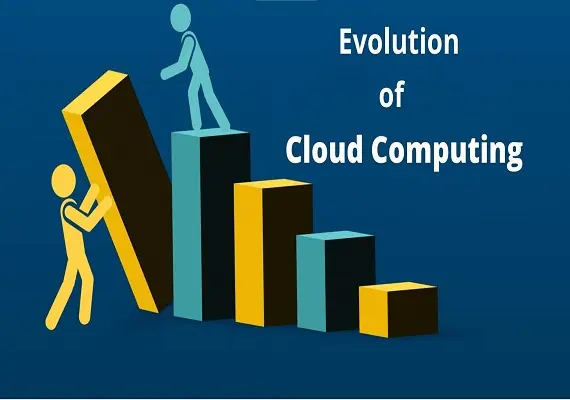The Evolution of Cloud Computing
- August 28, 2024
- Views 148
From Concept to Cornerstone of Modern Technology
Cloud computing has evolved from a niche concept into a fundamental component of the digital landscape. Over the past few decades, it has transformed how businesses operate, how developers create software, and how consumers interact with technology. The journey of cloud computing is a story of innovation, disruption, and the relentless pursuit of efficiency.
In this blog, we’ll explore the evolution of cloud computing, tracing its roots, understanding its current impact, and predicting where it might go next.
1. The Origins of Cloud Computing
The concept of cloud computing dates back several decades, long before it became a mainstream technology.
a. Early Beginnings: Time-Sharing and Virtualization
In the 1960s, the idea of time-sharing systems emerged, allowing multiple users to access a single computer simultaneously. This was an early precursor to cloud computing, as it demonstrated the feasibility of shared computing resources. The concept of virtualization, which allows multiple operating systems to run on a single physical machine, also played a crucial role in laying the groundwork for cloud computing.
b. The Emergence of the Internet
The growth of the internet in the 1990s provided the necessary infrastructure for cloud computing to take shape. The internet enabled the delivery of computing resources over a network, making it possible for users to access data and applications remotely.
c. Salesforce and the SaaS Model
In 1999, Salesforce introduced the Software as a Service (SaaS) model, offering its customer relationship management (CRM) software over the Internet. This was one of the first successful implementations of cloud computing, demonstrating that businesses could deliver software without requiring customers to install or maintain it on their hardware.
2. The Rise of Cloud Computing: 2000s to 2010s
The early 2000s marked the beginning of cloud computing as we know it today. Several key developments during this period helped propel cloud computing from a concept to a practical and essential tool.
a. The Launch of Amazon Web Services (AWS)
In 2006, Amazon launched Amazon Web Services (AWS), offering a suite of cloud-based services including storage, computing power, and databases. AWS introduced the concept of Infrastructure as a Service (IaaS), where businesses could rent computing infrastructure on a pay-as-you-go basis. This was a game-changer, as it allowed companies to scale their IT resources up or down based on demand, without investing in expensive hardware.
b. The Growth of Platform as a Service (PaaS)
Platform as a Service (PaaS) emerged as another layer of cloud computing, providing developers with a platform to build, deploy, and manage applications without worrying about the underlying infrastructure. Google App Engine, launched in 2008, was one of the early PaaS offerings, simplifying the development process and accelerating the time-to-market for new applications.
c. The Proliferation of SaaS
The success of Salesforce’s SaaS model inspired many other companies to offer software via the cloud. By the late 2000s, SaaS had become a dominant delivery model for a wide range of applications, from productivity tools like Google Workspace to enterprise software like Microsoft Office 365.
d. The Era of Multicloud and Hybrid Cloud
As businesses became more reliant on cloud computing, they began to adopt multi-cloud and hybrid cloud strategies. Multicloud involves using multiple cloud services from different providers, while hybrid cloud combines private and public cloud resources. These approaches offer greater flexibility, allowing businesses to optimize their IT environments based on specific needs.
3. The Impact of Cloud Computing Today
Cloud computing is now a cornerstone of modern technology, impacting nearly every aspect of business and everyday life.
a. Digital Transformation
Cloud computing has been a driving force behind digital transformation, enabling businesses to innovate faster, scale more efficiently, and respond more effectively to changing market conditions. Companies can now leverage cloud-based services to deploy new applications quickly, analyze large volumes of data, and improve customer experiences.
b. Remote Work and Collaboration
The COVID-19 pandemic accelerated the adoption of cloud-based collaboration tools, as businesses shifted to remote work. Platforms like Zoom, Microsoft Teams, and Google Meet, all powered by cloud computing, became essential for maintaining productivity and communication during lockdowns.
c. Cloud-Native Development
The rise of cloud-native development has transformed how software is built and deployed. Cloud-native applications are designed specifically for cloud environments, taking advantage of microservices architecture, containerization (e.g., Docker), and orchestration tools like Kubernetes. This approach enables faster development cycles, greater scalability, and more resilient applications.
d. The Explosion of Data and AI
The vast amounts of data generated in the digital age have driven the need for powerful cloud-based analytics and AI services. Cloud providers now offer advanced tools for data storage, processing, and machine learning, allowing businesses to extract valuable insights and make data-driven decisions.
e. Environmental Impact and Sustainability
As cloud computing grows, so does its environmental impact. However, many cloud providers are investing in renewable energy and more efficient data centers to mitigate their carbon footprint. The shift toward sustainable cloud practices is becoming increasingly important as businesses prioritize environmental responsibility.
4. The Future of Cloud Computing
As we look ahead, several trends are likely to shape the future of cloud computing.
a. Edge Computing
Edge computing is an emerging paradigm that brings computation and data storage closer to the location where it’s needed, rather than relying solely on centralized cloud data centers. This approach reduces latency, improves performance, and enables real-time processing for applications like autonomous vehicles, IoT devices, and smart cities. Edge computing will complement cloud computing, creating a more distributed and efficient computing ecosystem.
b. AI and Machine Learning Integration
Artificial intelligence (AI) and machine learning (ML) will become even more deeply integrated into cloud services. Cloud providers are likely to offer more specialized AI and ML tools, making it easier for businesses to develop and deploy intelligent applications. AI-powered cloud management tools will also help optimize resource allocation and improve cybersecurity.
c. Serverless Computing
Serverless computing, where the cloud provider automatically manages the infrastructure needed to run applications, is gaining traction. This model allows developers to focus on writing code without worrying about server management. As serverless technology matures, it will enable even more streamlined and cost-effective development processes.
d. Enhanced Security and Privacy
As cyber threats evolve, so too will the need for advanced cloud security measures. Cloud providers are expected to offer more sophisticated security tools, such as zero-trust architectures, end-to-end encryption, and AI-driven threat detection. Additionally, with growing concerns over data privacy, especially in light of regulations like GDPR, cloud services will need to ensure greater transparency and control over data handling.
e. Quantum Computing in the Cloud
Quantum computing, although still in its early stages, has the potential to revolutionize cloud computing by solving complex problems that are currently beyond the reach of classical computers. Cloud-based quantum computing services are beginning to emerge, providing researchers and developers with access to quantum processors. As technology advances, it could open up new possibilities for industries ranging from cryptography to pharmaceuticals.
5. Challenges Ahead
While the future of cloud computing is promising, it’s not without challenges.
a. Data Sovereignty and Compliance
As cloud adoption grows, so do concerns about data sovereignty—where data is stored and who has jurisdiction over it. Businesses operating in multiple countries must navigate a complex web of regulations, ensuring compliance with local laws while leveraging global cloud services.
b. Vendor Lock-In
The risk of vendor lock-in, where a business becomes overly reliant on a single cloud provider, remains a concern. Organizations are increasingly seeking solutions that allow for greater portability and interoperability between different cloud environments.
c. Skills Gap
As cloud computing evolves, there is a growing demand for skilled professionals who can manage and optimize cloud infrastructure. Addressing the skills gap will be crucial for businesses looking to fully capitalize on the benefits of cloud computing.
Conclusion
The evolution of cloud computing has been a remarkable journey, transforming from a conceptual idea into a foundational technology that powers the modern world. From its early roots in time-sharing systems to the sophisticated, multi-layered cloud ecosystems we see today, cloud computing has consistently pushed the boundaries of what’s possible.
As we move into the future, cloud computing will continue to evolve, driven by emerging technologies like edge computing, AI, and quantum computing. While challenges remain, the potential for innovation and growth is immense. Cloud computing is not just a technological trend; it’s a paradigm shift that will shape the future of business, technology, and society for years to come.






